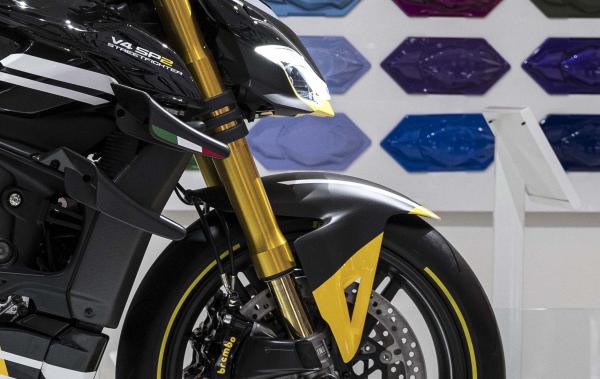
If you’re new to motorcycling (welcome, by the way) then the phrase 'upside-down forks' might leave you pondering a few entirely reasonably questions. Such as, why are they upside-down? If they are upside-down, why hasn’t someone put them back the right way up? And if they’re supposed to be upside-down, and that’s actually the right way up, then are they really upside-down at all?
All good questions, so let’s start at the beginning. The hydraulically damped telescopic fork has been part of motorcycle front ends since the 1935 BMW R17. Each fork leg is composed of two halves: a skinnier 'stanchion' tube, typically chromed, nestling inside a larger-diameter 'slider' outer tube. When the front wheel hits a bump some of the stanchion moves into the body of the slider, reducing the movement passed up to the rest of the bike and the rider. Lovely.
Image via Bonhams
Telescopic forks were traditionally mounted with the skinny inner tubes at the top and the fat outer tubes at the bottom. Stanchions are clamped into yokes either end of the frame’s headstock, while sliders hold the front wheel spindle. Nobody complained and things carried on happily like this until 1984, when KTM’s 495 MX off-roader arrived boasting a radical White Power (nowadays rebranded WP, for obvious reasons) fork that looked to have been fitted the wrong way up: fat sliders at the top, skinny stanchions down by the wheel.
The benefit was simple: rigidity. In use, telescopic forks are subjected to forces that try to bend the tubes. Grab a front brake hard and the decelerating front wheel will try to pull fork tubes inwards towards the rest of the bike, creating a fulcrum where the tube is clamped into the bottom yoke. Putting the bigger, stiffer, less-flexible slider tubes in the yokes means they’re better able to resist these bending forces than smaller, slimmer, weaker stanchions.
To test this at home, take a mechanical pencil and wind a decent length of lead out. Holding the body, waggle the pencil around violently and try to bend it. Now grab the skinny lead end and do the same. Thank goodness that’s not holding your front wheel on.
After several years the concept spread to road bikes. To the best of our knowledge the first production road bike with upside-down forks was the 1989 Kawasaki ZXR400 H1 (though if you can think of an earlier example please let us know). The following year Suzuki added inverted forks to the GSX-R750L Slingshot, and all of a sudden no self-respecting superbike could do without them.
As the 90s became the 00s the tech became more widespread, more fashionable and more affordable. By the mid-2000s every supersport 600 bike boasted a pair of must-have upside-down forks. Today economies of scale mean they’ve spread to 125s, scooters, tourers and even monkey bikes. Upside-down forks are everywhere.
But there are still exceptions, notably Yamaha’s MT-07 and Suzuki’s SV650, as well as most retro (Triumph Bonneville, Royal Enfield Interceptor) and custom/cruiser (Kawasaki Vulcan, Honda Rebel) machines. In these cases traditional forks are chosen either for aesthetic or cost reasons. Yamaha say conventional forks are cheaper to manufacture because less machining is required on the inner walls of the slider, while a smaller amount of stanchion surface needs plating. Don’t overlook the cost of a fork’s insides too: in the case of the MT and SV, it’s no coincidence that both use budget damper-rod internals.
Cost aside, are there any other benefits to mounting forks the traditional way? Having oil in the lower half of the fork means they can be slightly easier to service, especially if there’s a drain screw. Plus if a fork seal fails it’s harder for the oil to escape – with an upside-down fork, gravity encourages it to ooze down towards your brakes and tyre, which isn’t ideal.
Truth be told, regular road riders at regular road speeds don’t generate enough force to worry about fork flex, so for most of us upside-down forks offer minimal advantage, other than looking all snazzy and modern. When it comes to ride quality and chassis control, a fork’s internals, spring rate and damping quality are far more important than which way up the tubes have been mounted.

